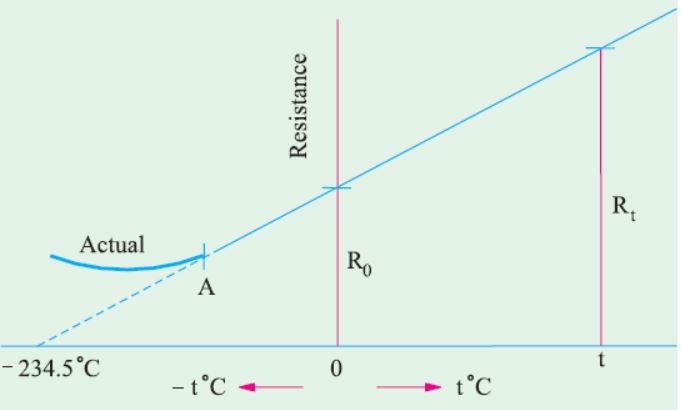Effect of Temperature on Resistance
The effect of rise in temperature is :
(i) to increase the resistance of pure metals. The increase is large and fairly regular for normal ranges of temperature. The temperature/resistance graph is a straight line (Fig. 1.6). As would be presently clarified, metals have a positive temperature co-efficient of resistance.
(ii) to increase the resistance of alloys, though in their case, the increase is relatively small and irregular. For some high-resistance alloys like Eureka (60% Cu and 40% Ni) and manganin, the increase in resistance is (or can be made) negligible over a considerable range of temperature.
(iii) to decrease the resistance of electrolytes, insulators (such as paper, rubber, glass, mica etc.) and partial conductors such as carbon. Hence, insulators are said to possess a negative temperature-coefficient of resistance.
Temperature Coefficient of Resistance
Let a metallic conductor having a resistance of R0 at 0°C be heated of t°C and let its resistance at this temperature be Rt. Then, considering normal ranges of temperature, it is found that the increase in resistance Δ R = Rt − R0 depends
(i) directly on its initial resistance
(ii) directly on the rise in temperature
(iii) on the nature of the material of the conductor.
or Rt − R0 ∝ R × t or Rt − R0 = α R0 t …………………………………………….(i)
where α (alpha) is a constant and is known as the temperature coefficient of resistance of the conductor. Rearranging Eq. (i),
we get α =

If R0 = 1 Ω, t = 1°C, then α = Δ R = Rt − R0
Hence, the temperature-coefficient of a material may be defined as :
the increase in resistance per ohm original resistance per °C rise in temperature.
From Eq. (i),
we find that Rt = R0 (1 + α t) …………………………………………..(ii)

It should be remembered that the above equation holds good for both rise as well as fall in temperature. As temperature of a conductor is decreased, its resistance is also decreased. In the above figure it is shown the temperature/resistance graph for copper and is practically a straight line. If this line is extended backwards, it would cut the temperature axis at a point where temperature is − 234.5°C (a number quite easy to remember). It means that theoretically, the resistance of copper conductor will become zero at this point though as shown by solid line, in practice, the curve departs from a straight line at very low temperatures.
Read article – Units of Resistivity
Visit NCERTworld.com for NCERT solutions and Textbook downloads

